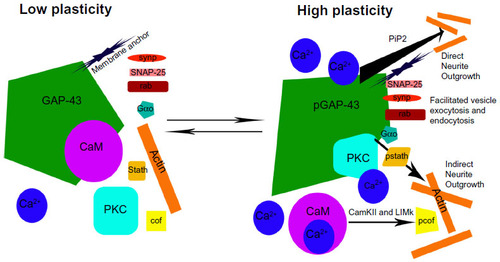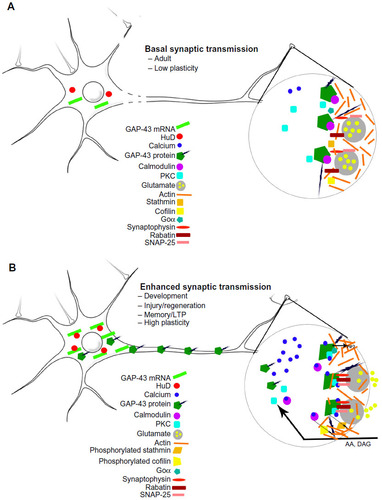Figures & data
Figure 1 GAP-43 protein interactions during low- and high-plasticity states.
Notes: During conditions of low plasticity, GAP-43 remains bound with CaM in the presence of low calcium (Ca2+). In conditions of high plasticity, elevated levels of Ca2+ dissociate CaM from GAP-43, allowing phosphorylation by PKC. In this condition, direct neurite outgrowth can be enhanced via interactions with PiP2 and enhanced vesicle recycling (endocytosis and exocytosis) can be enhanced vie interactions with synp, rab, and SNAP-25. Enhanced neurite outgrowth is also facilitated by pGAP-43 via interactions with the GTP-binding protein, Go (Goα) and phosphorylation of pstath. Finally, an indirect effect on neurotic outgrowth occurs via release of CaM and pcof via CamKII and LIMk.
Abbreviations: CaM, calmodulin; LIMk, LIM kinase; PiP2, phosphatidylinositol 4,5-bisphosphate; PKC, protein kinase C; synp, synaptophysin; rab, rabatin; SNAP-25, synaptosomal-associated protein 25; pGAP-43, phosphorylated GAP-43; pstath, phosphorylated stathmin; pcof, phosphorylation of cofilin; CamKII, Ca2+/calmodulin-dependent protein II.
Abbreviations: CaM, calmodulin; LIMk, LIM kinase; PiP2, phosphatidylinositol 4,5-bisphosphate; PKC, protein kinase C; synp, synaptophysin; rab, rabatin; SNAP-25, synaptosomal-associated protein 25; pGAP-43, phosphorylated GAP-43; pstath, phosphorylated stathmin; pcof, phosphorylation of cofilin; CamKII, Ca2+/calmodulin-dependent protein II.

Figure 2 Functional aspects of GAP-43 in the neuron.
Notes: (A) During basal synaptic transmission, the HuD protein is not bound to GAP-43, decreasing its stability and keeping protein levels low. GAP-43 bound of CaM precludes its plasticity-permissive functions. (B) During high-plasticity states, HuD binds to and stabilizes GAP-43 mRNA, thereby elevating protein levels. In the presynaptic terminal, GAP-43 phosphorylation by PKC facilitates neurite outgrowth and vesicle recycling, thereby leading to enhanced neurotransmitter release (glutamate). This enhanced glutamate release liberates post-synaptic AA and DAG which can facilitate pre-synaptic phosphorylation of GAP-43.
Abbreviations: AA, arachidonic acid; CaM, calmodulin; DAG, diacylglycerol; LTP, long-term potentiation; PKC, protein kinase C; SNAP-25, synaptosomal-associated protein 25.
Abbreviations: AA, arachidonic acid; CaM, calmodulin; DAG, diacylglycerol; LTP, long-term potentiation; PKC, protein kinase C; SNAP-25, synaptosomal-associated protein 25.

